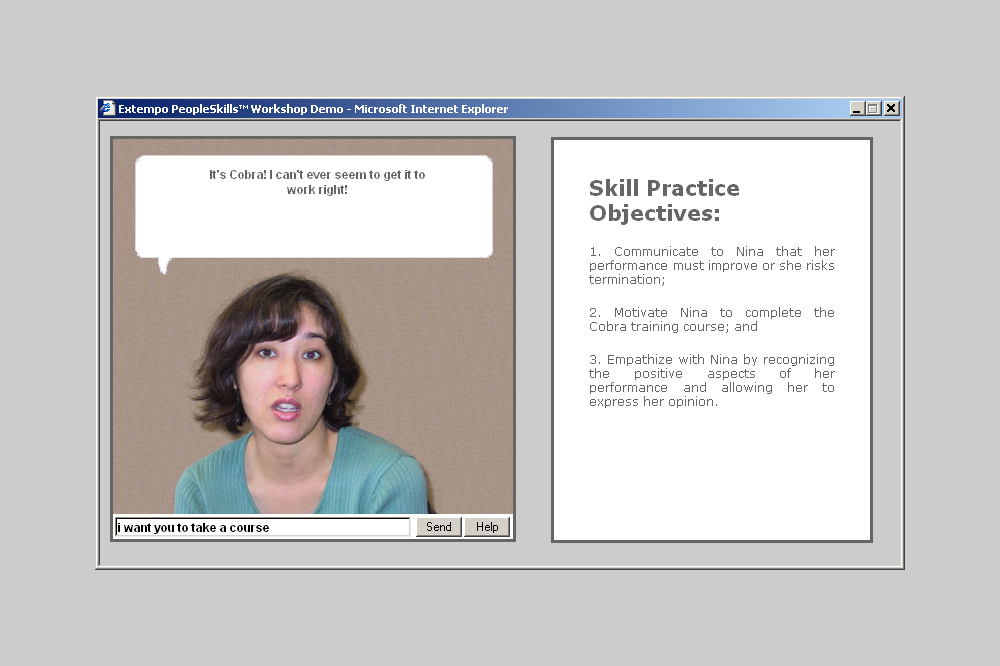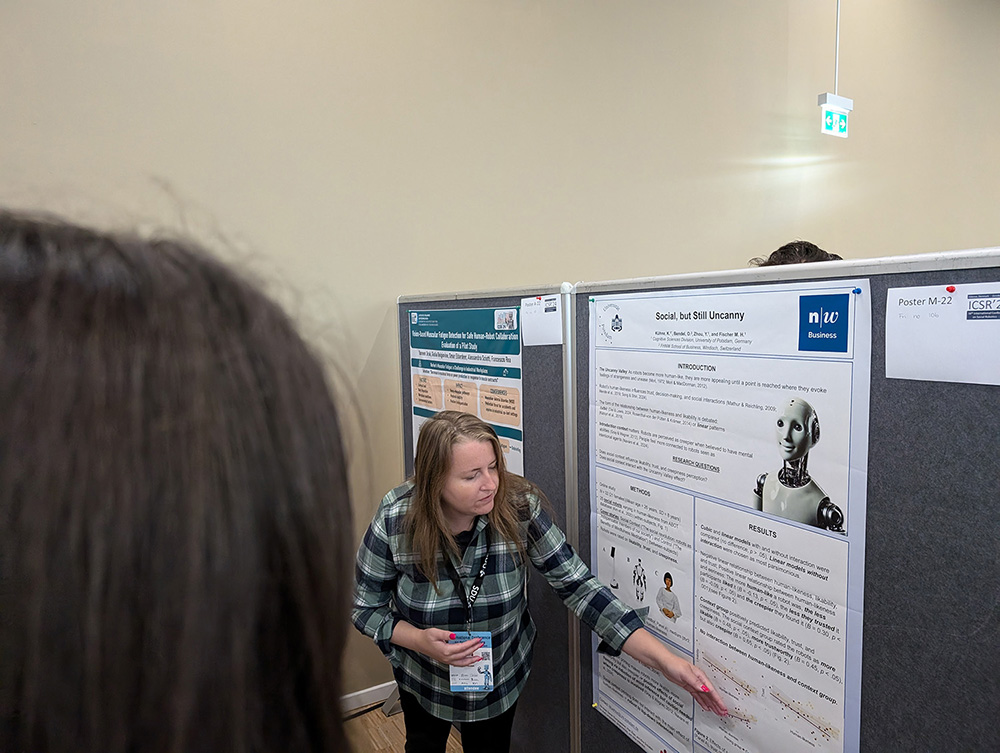Around the turn of the millennium, there were already numerous pedagogical agents, i.e., chatbots, voice assistants, and early social robots in learning environments. Names such as Virtual Learning Companions (VLCs) were also commonly used for the purely virtual versions. One of the companies that was ahead of its time was Extempo Systems, Inc. based in Redwood City, California. The company had evolved out of the Stanford Engineering School and designed and developed commercial agents for entertainment, business, and education: “Extempo makes e-learning products that help corporate employees perfect their people skills. The company’s approach allows every learner to achieve mastery of the people skills they need for effective management, teamwork, sales, customer service, and other critical business functions. Extempo’s products give learners authentic practice in a variety of job-specific conversational role-plays, along with expert individualized coaching throughout the learning process.” (Extempo Systems) One example was the virtual Nina, with whom you could communicate and who you were supposed to motivate to behave in a certain way. It wasn’t just the functionality that was impressive at the time, but also the design of the characters.
A Truck Tire for the Police
China’s latest crime-fighting innovation is RT-G, an AI-powered spherical police robot that not only stops crime, but somehow detects it. “Developed by a Shenzhen-based robotics company Logon Technology, the bot robocops are engineered to assist law enforcement in high-risk situations and, eventually, replace human officers in the line of fire.” (Firstpost.com, 12 December 2024) This was reported by the Indian platform Firstpost.com under the title “Meet RT-G, ‘spherical’ robot that is helping China to tackle crime”. According to The Sun, the spherical robot can operate on both land and water, and is able to withstand rough terrain and mud with ease. In some pictures, the robot looks as futuristic and attractive as BB-8’s body, in others like the clumsy tire of a truck or a bus. Whether such a model will be widely accepted by the population is questionable. But perhaps that’s not the point. Like Spot, RT-G is perhaps intended to create uncertainty. Something like this is more likely to harm robotics.
Award for ACI Paper
“The Animal Whisperer Project” by Oliver Bendel (FHNW School of Business) and Nick Zbinden (FHNW School of Business) won the Honourable Mention Short Paper Award at the 2024 ACI Conference. From the abstract: “Generative AI has become widespread since 2022. Technical advancements have resulted in multimodal large language models and other AI models that generate, analyze, and evaluate texts, images, and sounds. Such capabilities can be helpful in encounters between humans and animals. For example, apps with generative AI on a smartphone can be used to assess the body language and behavior of animals – e.g., during a walk or hike – and provide a recommendation for human behavior. It is often useful to take into account the animal’s environment and situation. The apps can help people to avert approaches and attacks, and thus also protect animals. In ‘The Animal Whisperer Project’, three apps were developed as prototypes based on the multimodal large language model GPT-4 from OpenAI from the beginning to mid-2024. Three specific GPTs resulted: the Cow Whisperer, the Horse Whisperer, and the Dog Whisperer. All three showed impressive capabilities after the first prompt engineering. These were improved by implementing information from expert interviews and adding labeled images of animals and other materials. AI-based apps for interpreting body language, behavior, and the overall situation can apparently be created today, without much effort, in a low-budget project. However, turning them into products would certainly raise questions, such as liability in the event of accidents.” The proceedings are available here.
Awards at ACI ’24
The “Proceedings of the International Conference on Animal-Computer Interaction 2024” were published at the end of November 2024, a few days before the conference in Glasgow. The following papers received awards: “Wireless Tension Sensors for Characterizing Dog Frailty in Veterinary Settings” by Colt Nichols (North Carolina State University), Yifan Wu (North Carolina State University), Alper Bozkurt, David Roberts (North Carolina State University) and Margaret Gruen (North Carolina State University): Best Paper Award; “Communication Functions in Speech Board Use by a Goffin’s Cockatoo: Implications for Research and Design” by Jennifer Cunha (Indiana University), Corinne Renguette (Perdue University), Lily Stella (Indiana University) and Clara Mancini (The Open University): Honourable Mention Award; “Surveying The Extent of Demographic Reporting of Animal Participants in ACI Research” by Lena Ashooh (Harvard University), Ilyena Hirskyj-Douglas (University of Glasgow) and Rebecca Kleinberger (Northeastern University): Honourable Mention Award; “Shelling Out the Fun: Quantifying Otter Interactions with Instrumented Enrichment Objects” by Charles Ramey (Georgia Institute of Technology), Jason Jones (Georgia Aquarium), Kristen Hannigan (Georgia Aquarium), Elizabeth Sadtler (Georgia Aquarium), Jennifer Odell (Georgia Aquarium), Thad Starner (Georgia Institute of Technology) and Melody Jackson (Georgia Institute of Technology): Best Short Paper Award; “The Animal Whisperer Project” by Oliver Bendel (FHNW School of Business) and Nick Zbinden (FHNW School of Business): Honourable Mention Short Paper Award.
Human Stuff from AI Characters
“Left to their own devices, an army of AI characters didn’t just survive – they thrived. They developed in-game jobs, shared memes, voted on tax reforms and even spread a religion.” (MIT Technology Review, 27 November 2024) This was reported by MIT Technology Review in an article on November 27. “The experiment played out on the open-world gaming platform Minecraft, where up to 1000 software agents at a time used large language models (LLMs) to interact with one another. Given just a nudge through text prompting, they developed a remarkable range of personality traits, preferences and specialist roles, with no further inputs from their human creators.” (MIT Technology Review, 27 November 2024) According to the magazine, the work by AI startup Altera is part of a broader field that seeks to use simulated agents to model how human groups would react to new economic policies or other interventions. The article entitled “These AI Minecraft characters did weirdly human stuff all on their own” can be accessed here.
Trump is Guarded by Spot
Spot from Boston Dynamics is the latest tool in the arsenal of the US Secret Service. This was reported by the BBC on November 17, 2024. The robot was recently spotted patrolling the perimeter of President-elect Donald Trump’s Mar-a-Lago resort in Palm Beach, Florida. As the video on the website shows, they do not carry weapons; “and each can be controlled remotely or automatically – as long as its route is pre-programmed”. Passers-by are warned by a sign on each of Spot’s legs that reads, “DO NOT PET”. “I don’t know that anyone would be tempted to pet these robot dogs. They do not look cuddly,” Melissa Michelson, a political scientist at Menlo College, told the BBC. Oliver Bendel, an expert in social robotics at the FHNW School of Business, disagrees. He has been working with Unitree Go2, which is half the weight and smaller than SPOT but otherwise comparable, since 2023. “The students are initially amazed or shocked when they see it. After a minute or two, their doubts are dispelled and they try to lure it in and stroke it.” A robot like Spot is well suited to an estate like Mar-a-Lago. However, models such as K5 from Knightscope or RBwatcher from Robotnik/URG can also be used on the lawns.
Grandma Daisy Tricks Phone Scammers
“Human-like AIs have brought plenty of justifiable concerns about their ability to replace human workers, but a company is turning the tech against one of humanity’s biggest scourges: phone scammers. The AI imitates the criminals’ most popular target, a senior citizen, who keeps the fraudsters on the phone as long as possible in conversations that go nowhere, à la Grandpa Simpson.” (Techspot, 14 November 2024) This is reported by Techspot in an article from November 14, 2024. In this case, an AI grandmother is sicced on the fraudsters. “The creation of O2, the UK’s largest mobile network operator, Daisy, or dAIsy, is an AI created to trick scammers into thinking they are talking to a real grandmother who likes to ramble. If and when the AI does hand over the demanded bank details, it reads out fake numbers and names.” (Techspot, 14 November 2024) Daisy works by listening to a caller and transcribing his or her voice to text. Responses are generated by a large language model (LLM), complete with character personality layer, and then fed back through a custom AI text-to-speech model to generate a voice response. All this happens in real time, as the magazine reports. As phone scammers use more and more AI in their calls, you will soon find AI systems trying to outsmart each other.
The kAIxo Project
The interim presentation of the kAIxo project took place on 11 November 2024. Nicolas Lluis Araya is the project collaborator. Chatbots for dead, endangered, and extinct languages are being developed at the FHNW School of Business. One well-known example is @llegra, a chatbot for Vallader. Oliver Bendel recently tested the reach of GPTs for endangered languages such as Irish (Irish Gaelic), Maori, and Basque. According to ChatGPT, there is a relatively large amount of training material available for them. On 12 May 2024 – after Irish Girl and Maori Girl – a first version of Adelina, a chatbot for Basque, was created. It was later improved in a second version. As part of the “kAIxo” project (the Basque “kaixo” corresponds to the English “hello”), the chatbot or voice assistant kAIxo is being built to speak Basque. Its purpose is to keep users practising written or spoken language or to develop the desire to learn the endangered language. The chatbot is based on GPT-4o. Retrieval-Augmented Generation (RAG) plays a central role. A ChatSubs dataset is used, which contains dialogues in Spanish and three other official Spanish languages (Catalan, Basque, and Galician). Nicolas Lluis Araya presented a functioning prototype at the interim presentation. This is now to be expanded step by step.
Social Robots in Olten
The elective module “Social Robots” by Prof. Dr. Oliver Bendel took place from November 4 to 6, 2024 at the Olten Campus. Tamara Siegmann (with the online presentation of the paper “Social and Collaborative Robots in Prison”) was invited as a guest speaker. She made it clear to those present that every member of the university can make a contribution to research. On site were Pepper and NAO from the FHNW Robo Labs as well as Unitree Go2, Alpha Mini, Cozmo, Furby, and Booboo (aka Boo Boo) from Oliver Bendel’s privately funded Social Robots Lab. Unitree Go2 – also called Bao (Chinese for “treasure, darling”) by the lecturer – and Booboo were particularly well received. At the end of the elective module, the students designed social robots – also with the help of generative AI – that they found useful, meaningful or simply attractive. The elective modules have been offered since 2021 and are very popular.
The Uncanny Social Robot
The uncanny valley effect is a famous hypothesis. Whether it can be influenced by context is still unclear. In an online experiment, Katharina Kühne and her co-authors Oliver Bendel, Yuefang Zue, and Martin Fischer found a negative linear relationship between a robot’s human likeness and its likeability and trustworthiness, and a positive linear relationship between a robot’s human likeness and its uncaniness. “Social context priming improved overall likability and trust of robots but did not modulate the Uncanny Valley effect.” (Abstract) Katharina Kühne outlined these conclusions in her presentation “Social, but Still Uncanny” – the title of the paper – at the International Conference on Social Robotics 2024 in Odense, Denmark. Like Yuefang Zue and Martin Fischer, she is a researcher at the University of Potsdam. Oliver Bendel teaches and researches at the FHNW School of Business. Together with Tamara Siegmann, he presented a second paper at the ICSR.









